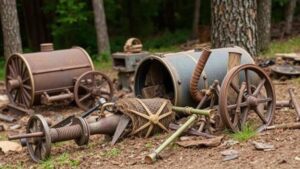Detecting for Coins in Urban Alleyways and Forgotten Courtyards
Detecting for Coins in Urban Alleyways and Forgotten Courtyards
Urban environments often conceal a treasure trove of history just beneath the surface. Among the most intriguing activities is coin detecting in alleyways and forgotten courtyards, where remnants of everyday life from past generations remain buried under layers of dirt and debris. This article explores the techniques, equipment, historical context, and best practices for successful coin detecting in these often-overlooked urban spaces.
Understanding the Urban Landscape
Urban areas are unique ecosystems where human activity has significantly altered the original landscape. Many cities possess courtyards and alleyways that reflect rich historical narratives. For example, many alleyways in Chicago date back to the late 19th century, serving as thoroughfares for deliveries and refuse–providing a rich hunting ground for coin enthusiasts.
Understanding the specific history and usage of these spaces can maximize success in locating coins. For example, locations near former marketplaces or taverns often yield a higher concentration of coins as these areas were frequented by merchants and pedestrians.
The Equipment of Choice
To embark on a coin-detecting adventure in urban settings, having the right equipment is essential. Below are key tools and technologies:
- Metal Detector: A high-quality metal detector designed for coin hunting is mandatory. Models such as the Minelab Equinox 800 or Garrett AT Pro are highly recommended for their sensitivity to small metal objects and their ability to discriminate between different metal types.
- Digging Tools: A trowel or a specialized coin retrieval tool will enable you to dig carefully without damaging the coins or the surrounding area, essential in urban settings with fragile surfaces.
- Headphones: Using headphones helps in detecting subtle changes in sound, allowing for the identification of deeper or smaller targets.
- GPS Device: A GPS can be useful for marking successful digging spots for future exploration or for tracking areas that have already been scoured.
Techniques for Successful Detecting
The method of detecting coins in urban alleyways and courtyards can significantly impact the results. A strategic approach involves several critical steps:
- Research: Prior to heading out, conduct background research on the history of the location. Online resources, library archives, and local historical societies can provide invaluable information.
- Grid Method: This technique involves dividing the area into sections and scanning each systematically, ensuring no locations are overlooked.
- Adjusting Settings: Settings on your metal detector should be adjusted based on ground conditions and the type of coins you are searching for. Urban environments may have more interference, necessitating changes in sensitivity and discrimination settings.
- Timing and Conditions: The best times to detect are early mornings or late afternoons, especially after rainfall when the ground is soft, making coins easier to uncover.
Examples and Case Studies
Several avid detectorists have shared their successful expeditions, illustrating the potential rewards of urban coin detecting. For example, in a well-documented case in Philadelphia, hunter Bob Smith recovered over 200 coins, some dating back to the early 1800s, from an alleyway behind a historic tavern. His meticulous research and grid scanning method allowed him to pinpoint the specific sections of the alley that were often overlooked by others.
Another notable example can be found in London’s East End, where enthusiasts often search near old market sites. In one season, a group discovered a rare Victorian penny, fetching thousands at auction, highlighting the financial potential hidden within these urban landscapes.
Legal and Ethical Considerations
Engaging in coin detecting comes with the responsibility to respect local regulations and the environment. Always check if you need permits for detecting in public spaces, and be aware of property lines to avoid trespassing. Reporting significant finds to local museums or historical societies can also enhance community relations and preserve local heritage.
Actionable Takeaways
To wrap up, detecting coins in urban alleyways and forgotten courtyards presents a unique opportunity to connect with history while enjoying the thrill of the hunt. By employing the right techniques, investing in quality equipment, and observing legal guidelines, treasure seekers can uncover hidden gems of the past. As you prepare for your next adventure, consider the following actions:
- Research the history of your selected area.
- Invest in a reliable metal detector suited to your needs.
- Use systematic methods to ensure thorough coverage.
- Respect local laws and ethical standards in your endeavors.
With patience and dedication, the next forgotten coin waiting to be discovered could be just around the corner.

